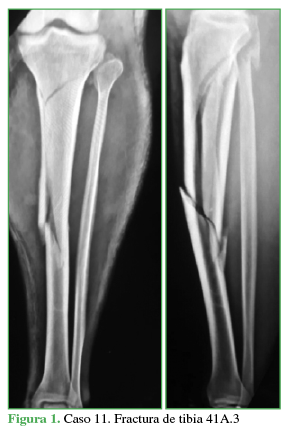Tratamiento con clavo endomedular de las fracturas metafisarias proximales y distales de tibia. Abordaje pararrotuliano medial en posición de semiextensión
Contenido principal del artículo
Resumen
Materiales y Métodos: Se incluyó a 23 pacientes con un seguimiento posoperatorio mínimo de un año. Doce eran fracturas distales de tibia; 9, proximales y 2, segmentarias. Se evaluaron el rango de movilidad de la rodilla, el dolor posoperatorio con la escala de Lysholm, el eje posoperatorio y la tasa de consolidación.
Resultados: El arco de movilidad de la rodilla fue de 125° (rango 110-140). Al año de la cirugía, 16 de 23 pacientes no tenían dolor, 5 de 23 refirieron un leve dolor durante la actividad física y 2, dolores intensos durante la actividad física. En todos los casos, se consiguió un eje posoperatorio aceptable y la consolidación ósea. Un paciente requirió un aumento con una placa e injerto óseo.
Conclusión: La colocación de un clavo de tibia a través de un abordaje pararrotuliano medial con la rodilla en semiextensión es una técnica segura y simple para el tratamiento de las fracturas metafisarias de tibia.
Descargas
Métricas
Detalles del artículo
La aceptación del manuscrito por parte de la revista implica la no presentación simultánea a otras revistas u órganos editoriales. La RAAOT se encuentra bajo la licencia Creative Commons 4.0. Atribución-NoComercial-CompartirIgual (http://creativecommons.org/licenses/by-nc-sa/4.0/deed.es). Se puede compartir, copiar, distribuir, alterar, transformar, generar una obra derivada, ejecutar y comunicar públicamente la obra, siempre que: a) se cite la autoría y la fuente original de su publicación (revista, editorial y URL de la obra); b) no se usen para fines comerciales; c) se mantengan los mismos términos de la licencia.
En caso de que el manuscrito sea aprobado para su próxima publicación, los autores conservan los derechos de autor y cederán a la revista los derechos de la publicación, edición, reproducción, distribución, exhibición y comunicación a nivel nacional e internacional en las diferentes bases de datos, repositorios y portales.
Se deja constancia que el referido artículo es inédito y que no está en espera de impresión en alguna otra publicación nacional o extranjera.
Por la presente, acepta/n las modificaciones que sean necesarias, sugeridas en la revisión por los pares (referato), para adaptar el trabajo al estilo y modalidad de publicación de la Revista.
Citas
2. Freedman EL, Johnson EE. Radiographic analysis of tibial fracture malalignment following intramedullary nailing. Clin Orthop Relat Res 1995;(315):25-33. PMID: 7634677
3. Lang GJ, Cohen BE, Bosse MJ, Kellam JF. Proximal third tibial shaft fractures: should they be nailed? Clin Orthop Relat Res 1995;(315):64-74. PMID: 7634688
4. Lindvall E, Sanders R, DiPasquale T, Herscovici D, Haidukewych G, Sagi C. Intramedullary nailing versus percutaneous locked plating of extra-articular proximal tibial fractures: comparison of 56 cases. J Orthop Trauma 2009;23(7):485-92. https://doi.org/10.1097/BOT.0b013e3181b013d2
5. Yaligod V, Rudrappa GH, Nagendra S, Shivanna UM. Minimizing the complications of intramedullary nailing for distal third tibial shaft and metaphyseal fractures. J Orthop 2013;11(1):10-8. https://doi.org/10.1016/j.jor.2013.12.002
6. Tornetta P 3rd, Collins E. Semiextended position of intramedullary nailing of the proximal tibia. Clin Orthop 1996;(328):185-9. https://doi.org/10.1097/00003086-199607000-00029
7. Kubiak EN, Widmer BJ, Horwitz DS. Extra-articular technique for semiextended tibial nailing. J Orthop Trauma 2010;24(11):704-8. https://doi.org/10.1097/BOT.0b013e3181d5d9f4
8. Cole JD. Distal tibia fracture: Opinion: intramedullary nailing. J Orthop Trauma 2006;20:73-4. https://doi.org/10.1097/01.bot.0000196658.55293.e6
9. Gustilo RD, Anderson JT. Prevention of infection in the treatment of one thousand and twenty-five open fractures of long bones: retrospective and prospective analysis. J Bone Joint Surg Am 1976;58:453-8. PMID: 773941
10. Collins NJ, Misra D, Felson DT, Crossley KM, Roos EM. Measures of knee function: International Knee Documentation Committee (IKDC) Subjective Knee Evaluation Form, Knee Injury and Osteoarthritis Outcome Score (KOOS), Knee Injury and Osteoarthritis Outcome Score Physical Function Short Form (KOOS-PS), Knee Outcome Survey Activities of Daily Living Scale (KOS-ADL), Lysholm Knee Scoring Scale, Oxford Knee Score (OKS), Western Ontario and McMaster Universities Osteoarthritis Index (WOMAC), Activity Rating Scale (ARS), and Tegner Activity Score (TAS). Arthritis Care Res (Hoboken) 2011;63(Suppl 11):S208-28. https://doi.org/10.1002/acr.20632
11. Vallier HA, Le TT, Bedi A. Radiographic and clinical comparison of distal tibia shaft fractures (4 to 11 cm proximal to the plafond): plating versus intramedullary nailing. J Orthop Trauma 2008;22(5):307-11. https://doi.org/10.1097/BOT.0b013e31816ed974
12. Nork SE, Barei DP, Schildhauer TA. Intramedullary nailing of proximal quarter tibial fractures. J Orthop Trauma 2006;20(8):523-8. https://doi.org/10.1097/01.bot.0000244993.60374.d6
13. Sanders RW, DiPasquale TG, Jordan CJ, Arrington JA, Sagi HC. Semiextended intramedullary nailing of the tibia using a suprapatellar approach: radiographic results and clinical outcomes at a minimum of 12 months follow-up. J Orthop Trauma 2014;28(5):245-55. https://doi.org/10.1097/BOT.0000000000000082
14. Ryan SP, Steen B, Tornetta P 3rd. Semi-extended nailing of metaphyseal tibia fractures: alignment and incidence of postoperative knee pain. J Orthop Trauma 2014;28(5):263-9. https://doi.org/10.1097/BOT.0000000000000083
15. Rothberg DL, Stuart AR, Presson AP, Haller JM, Higgins TF, Kubiak EN. A comparison of the open semi-extended parapatellar versus standard entry tibial nailing techniques and knee pain: a randomized controlled trial. J Orthop Trauma 2019;33(1):31-6. https://doi.org/10.1097/BOT.0000000000001309
16. Ibrahim I, Johnson A, Rodriguez EK. Improved outcomes with semi-extended nailing of tibial fractures? A systematic review. J Orthop Trauma 2019;33(3):155-60. https://doi.org/10.1097/BOT.0000000000001395
17. Mitchell PM, Weisenthal BM, Collinge CA. No incidence of postoperative knee sepsis with suprapatellar nailing of open tibia fractures. J Orthop Trauma 2017;31(2):85-9. https://doi.org/10.1097/BOT.0000000000000725

